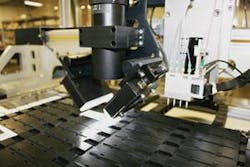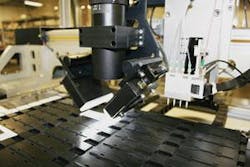Flexible, cost-effective design opens opportunities
A discussion with Markus Tarin, MoviMED
VSD: What sort of systems or services does your company provide?
Tarin: MoviMED specializes in custom imaging solutions for the medical, scientific, and industrial markets. The company is known as a go-to place when it comes to imaging problems that cannot be solved by simply attaching a lens to a smart camera. I like to refer to these simpler systems as the “conveyor-belt-type applications.”
Traditionally, we have been integrating not only vision but also motion-control systems to either move the camera or the objects under the camera. Most often we find ourselves in the proposal phase for just a vision system, but we actually end up automating the entire machine or process. Our clients appreciate the added value of a fully integrated solution and welcome the simplicity of only having to deal with a single graphical user interface for their complete process.
The company name MoviMED actually is made up of three words: Motion, Vision, Medical. However, due to our expertise and focus on image processing, we have ventured out into a variety of other industry sectors. We have installations in the medical, biomedical, pharmaceutical, general-manufacturing, textile, research, automotive, aerospace, security, and defense markets. After founding the company in 1999 we joined the National Instruments (NI; Austin, TX, USA; www.ni.com) “Alliance Partner” program. It was a perfect fit for us.
VSD: How do you select the technologies and components that you use?
Tarin: The type of machine-vision components we are using is largely driven by the requirements of our customers’ applications. We always make sure to select the most cost-effective components; however, this sometimes interferes with the desired performance of the system. In that case, we try to educate our clients on the impact certain requirements may have on the cost of critical components. Often this kind of clarification can save thousands of dollars because some specifications have been put down as “wants” rather than “musts.”
The overwhelming number of machine-vision components available today is adding to the confusion. That’s where our consulting services help select the most appropriate components for any particular application. MoviMED is somewhat unique in that aspect, since we are actually reselling a variety of machine-vision components in addition to our integration services. Over the years we have developed close relationships with our vendors, which provide us with resources and a wealth of information about the products we integrate. We have even custom-designed telecentric lenses and other optical components when no off-the-shelf product suited the application
VSD: How do you evaluate the performance of the cameras on the market?
Tarin: After being involved in the industry for so many years, it still makes me shake my head when I see how some manufacturers publish their camera specifications. I understand how competitive the general machine-vision camera market is. And there is really only so much any one camera manufacturer can do, especially since most standard cameras are using a sensor from Micron, Sony, or Kodak. However, we have seen significant differences between cameras manufacturers that were using the same image sensor with respect to noise levels, antiblooming, and advertised dynamic ranges.
The most misused or abused camera specification is the dynamic range. Over and over I see either camera manufacturers or other “experts” equate the bit-depth of the ADC in a camera with the dynamic range of the overall system (camera). The dynamic range of a sensor is defined by the largest possible signal divided by the smallest possible signal it can generate. This can be of importance in certain applications. Especially in scientific or medical imaging where results depend on subtle differences in gray values, but also in machine-vision applications when using subpixel accuracy, for example.
The upper end depends on the well capacity of a pixel in the sensor and the lower end is usually limited by the noise floor. If you exceed the well capacity, you saturate the well with electrons and potentially cause a spillover into neighboring pixels (blooming). In the other direction you create uncertainty, since your lowest gray level is at some point overshadowed by noise and it no longer produces useful information. All this is a characteristic of the image sensor alone and has nothing to do with capability of the ADC used in that camera.
VSD: How do you design systems for OEM product obsolescence?
Tarin: One factor driving us to use NI tools for our development is the interchangeability and hardware layer abstraction its software offers. This not only benefits our clients when it comes to replacing an obsolete camera, it also helps when a system needs to be upgraded with more powerful system components. All hardware components can be replaced with different models with little or no changes in the application software. This open architecture makes the core application independent from changes in the marketplace.
VSD: In which area of the industry do you see the most growth?
Tarin: We see a lot of “noise” in the pharmaceutical industry for rapid drug discovery and point-of-care testing applications. Microspot array imaging is an area we have been working in for the past three years. The same kind of technology also is being utilized heavily in the defense-and-security sector with the hunt for developing rapid biological-agent detection systems.
Over the past few years we noticed that our clients’ demands have increased and have also shifted. No longer is it sufficient to be knowledgeable about machine-vision systems and software alone. If you want to succeed as a machine-vision integrator you need to have a considerable amount of domain expertise, as well. Most of our customers do not “speak” machine vision. They are experts in their domain and they expect someone that can interface with their technology on a technical level as well as from a communications standpoint.
VSD: How will machine-vision components have to change to meet future needs?
Tarin: The need for speed and higher performance will always be there. However, I think it is time for more revolutionary changes in the machine-vision industry. Nothing really groundbreaking has emerged over the past decade in the commercial market. When compared to human vision, machine vision is still very limited. As long as your application is in a controlled environment, it works reliably. Take that control away and you have a whole new world in front of you. We need adaptive technologies that can deal with uncontrolled environments, with cognitive capabilities matching or exceeding the human vision model.
We need dynamic ranges exceeding 120 dB in cameras combined with event-based imaging. Just think about the insanity that goes on in frame-based imaging. We are forced to “poll” a camera frame by frame, then process multimegapixel images just to extract temporal or spatial information that makes up maybe 3% of the total data processed. What an achievement!
VSD: Please discuss the issue of intellectual property rights and what can be done to protect them.
Tarin: Protecting intellectual property, such as source code and mechanical drawings, is no longer the sole interest of the creator. The risk exposure in today’s world of global technology development is increasing. Large corporations are outsourcing the development of key technologies to smaller, service-oriented companies. These companies thrive on their high degree of specialization and on their intellectual property built around their niche market. However, from a risk-management perspective, large corporations usually demand transfer of all intellectual property. This contingency in itself makes it a double-edged sword to do business with “the big guys.” For a small company this usually means turning down a significant opportunity in order to protect its intellectual property or giving up some of its portfolio to gain a new client.
We found a common solution for this problem. It’s called “Technology Escrow.” The underlying idea is to involve a stable and neutral third party, similar to purchasing a house. This technology escrow company (for example, www.ironmountain.com) allows the involved parties to create an escrow account for the purpose of safeguarding the intellectual property for the lifetime of the developed system.
VSD: What applications and industry trends do you expect to emerge?
Tarin: I believe that we will see more and more nonmachine-vision-type of applications emerging. Homeland security is already driving a huge wave of intelligent surveillance developments, for example.
Also the optical nondestructive-testing market is predicted to outpace the growth rate of traditional machine-vision markets. MoviMED positioned itself in this market segment a year ago. We have unique solutions for lock-in and pulse thermography for nondestructive testing. Our systems increase the signal-to-noise ratio of IR cameras by a factor of 1000. Infrared cameras are currently reaching a “sweet-spot” with their price/performance point. We will see more applications in automation using IR cameras, where their application has been cost-prohibitive in the past.
Markus Tarin is the president and CEO of MoviMED (Irvine, CA, USA; www.movimed.com). He graduated from the Higher Technical College in Hanover, Germany, where he started his career in the vision industry working with CRT-based analog cameras. Editor in chief Conard Holton spoke with him about new applications, performance specifications, and intellectual property rights.


